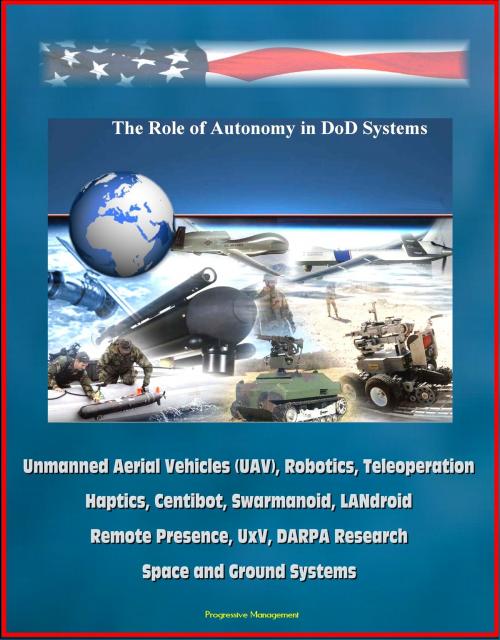The Role of Autonomy in DOD Systems - Unmanned Aerial Vehicles (UAV), Robotics, Teleoperation, Haptics, Centibot, Swarmanoid, LANdroid, Remote Presence, UxV, DARPA Research, Space and Ground Systems
Nonfiction, Science & Nature, Technology, Robotics, Aeronautics & Astronautics| Author: | Progressive Management | ISBN: | 9781301033881 |
| Publisher: | Progressive Management | Publication: | February 21, 2013 |
| Imprint: | Smashwords Edition | Language: | English |
| Author: | Progressive Management |
| ISBN: | 9781301033881 |
| Publisher: | Progressive Management |
| Publication: | February 21, 2013 |
| Imprint: | Smashwords Edition |
| Language: | English |
The DSB Task Force on the Role of Autonomy in DoD Systems was asked to study relevant technologies, ongoing research, and the current autonomy-relevant plans of the Military Services, to assist the DoD in identifying new opportunities to more aggressively use autonomy in military missions, to anticipate vulnerabilities, and to make recommendations for overcoming operational difficulties and systemic barriers to realizing the full potential of autonomous systems. The Task Force has concluded that, while currently fielded unmanned systems are making positive contributions across DoD operations, autonomy technology is being underutilized as a result of material obstacles within the Department that are inhibiting the broad acceptance of autonomy and its ability to more fully realize the benefits of unmanned systems. Overall, the Task Force found that unmanned systems are making a significant, positive impact on DoD objectives worldwide. However, the true value of these systems is not to provide a direct human replacement, but rather to extend and complement human capability by providing potentially unlimited persistent capabilities, reducing human exposure to life threatening tasks, and with proper design, reducing the high cognitive load currently placed on operators/supervisors.
Unmanned systems are proving to have a significant impact on warfare worldwide. The true value of these systems is not to provide a direct human replacement, but rather to extend and complement human capability in a number of ways. These systems extend human reach by providing potentially unlimited persistent capabilities without degradation due to fatigue or lack of attention. Unmanned systems offer the warfighter more options and flexibility to access hazardous environments, work at small scales, or react at speeds and scales beyond human capability. With proper design of bounded autonomous capabilities, unmanned systems can also reduce the high cognitive load currently placed on operators/supervisors. Moreover, increased autonomy can enable humans to delegate those tasks that are more effectively done by computer, including synchronizing activities between multiple unmanned systems, software agents and warfighters—thus freeing humans to focus on more complex decision making.
1.0 Executive Summary * 1.1. Misperceptions about Autonomy are Limiting its Adoption * 1.2. Create an Autonomous Systems Reference Framework to Replace "Levels of Autonomy" * 1.3. Technical Challenges Remain, Some Proven Autonomy Capability Underutilized * 1.4. Autonomous Systems Pose Unique Acquisition Challenges * 1.5. Avoid Capability Surprise by Anticipating Adversary Use of Autonomous Systems * 2.0 Operational Benefits of Autonomy * 2.1. Unmanned Aerial Vehicles * 2.2. Unmanned Ground Systems * 2.3. Unmanned Maritime Vehicles * 2.4. Unmanned Space Systems * 2.5. Conclusion * 3.0 Technical Issues of Autonomy * 3.1. Motivation: What Makes Autonomy Hard * 3.2. Defining Levels of Autonomy is Not Useful * 3.3. Autonomous System Reference Framework * 3.4. Needed Technology Development * 3.5. Technical Recommendations * 4.0 Acquisition Issues of Autonomy * 4.1. Requirements and Development * 4.2. Test and Evaluation * 4.3. Transition to Operational Deployment * 5.0 Capability Surprise in Autonomy Technology * 5.1. Overview of Global Unmanned Systems * 5.2. Unmanned Symmetric Adversary Scenarios * 5.3. Value for Asymmetric Adversaries * 5.4. External Vulnerabilities * 5.5. Self-Imposed Vulnerabilities * 5.6. Recommendations . * Appendix A—Details of Operational Benefits by Domain * A.1. Aerial Systems Strategy * A.2. Maritime Systems * A.3. Ground Systems * A.4. Space Systems * Appendix B—Bibliography * Appendix C—Task Force Terms of Reference * Appendix D—Task Force Membership * Appendix E—Task Force Briefings * Appendix F—Glossary
The DSB Task Force on the Role of Autonomy in DoD Systems was asked to study relevant technologies, ongoing research, and the current autonomy-relevant plans of the Military Services, to assist the DoD in identifying new opportunities to more aggressively use autonomy in military missions, to anticipate vulnerabilities, and to make recommendations for overcoming operational difficulties and systemic barriers to realizing the full potential of autonomous systems. The Task Force has concluded that, while currently fielded unmanned systems are making positive contributions across DoD operations, autonomy technology is being underutilized as a result of material obstacles within the Department that are inhibiting the broad acceptance of autonomy and its ability to more fully realize the benefits of unmanned systems. Overall, the Task Force found that unmanned systems are making a significant, positive impact on DoD objectives worldwide. However, the true value of these systems is not to provide a direct human replacement, but rather to extend and complement human capability by providing potentially unlimited persistent capabilities, reducing human exposure to life threatening tasks, and with proper design, reducing the high cognitive load currently placed on operators/supervisors.
Unmanned systems are proving to have a significant impact on warfare worldwide. The true value of these systems is not to provide a direct human replacement, but rather to extend and complement human capability in a number of ways. These systems extend human reach by providing potentially unlimited persistent capabilities without degradation due to fatigue or lack of attention. Unmanned systems offer the warfighter more options and flexibility to access hazardous environments, work at small scales, or react at speeds and scales beyond human capability. With proper design of bounded autonomous capabilities, unmanned systems can also reduce the high cognitive load currently placed on operators/supervisors. Moreover, increased autonomy can enable humans to delegate those tasks that are more effectively done by computer, including synchronizing activities between multiple unmanned systems, software agents and warfighters—thus freeing humans to focus on more complex decision making.
1.0 Executive Summary * 1.1. Misperceptions about Autonomy are Limiting its Adoption * 1.2. Create an Autonomous Systems Reference Framework to Replace "Levels of Autonomy" * 1.3. Technical Challenges Remain, Some Proven Autonomy Capability Underutilized * 1.4. Autonomous Systems Pose Unique Acquisition Challenges * 1.5. Avoid Capability Surprise by Anticipating Adversary Use of Autonomous Systems * 2.0 Operational Benefits of Autonomy * 2.1. Unmanned Aerial Vehicles * 2.2. Unmanned Ground Systems * 2.3. Unmanned Maritime Vehicles * 2.4. Unmanned Space Systems * 2.5. Conclusion * 3.0 Technical Issues of Autonomy * 3.1. Motivation: What Makes Autonomy Hard * 3.2. Defining Levels of Autonomy is Not Useful * 3.3. Autonomous System Reference Framework * 3.4. Needed Technology Development * 3.5. Technical Recommendations * 4.0 Acquisition Issues of Autonomy * 4.1. Requirements and Development * 4.2. Test and Evaluation * 4.3. Transition to Operational Deployment * 5.0 Capability Surprise in Autonomy Technology * 5.1. Overview of Global Unmanned Systems * 5.2. Unmanned Symmetric Adversary Scenarios * 5.3. Value for Asymmetric Adversaries * 5.4. External Vulnerabilities * 5.5. Self-Imposed Vulnerabilities * 5.6. Recommendations . * Appendix A—Details of Operational Benefits by Domain * A.1. Aerial Systems Strategy * A.2. Maritime Systems * A.3. Ground Systems * A.4. Space Systems * Appendix B—Bibliography * Appendix C—Task Force Terms of Reference * Appendix D—Task Force Membership * Appendix E—Task Force Briefings * Appendix F—Glossary















